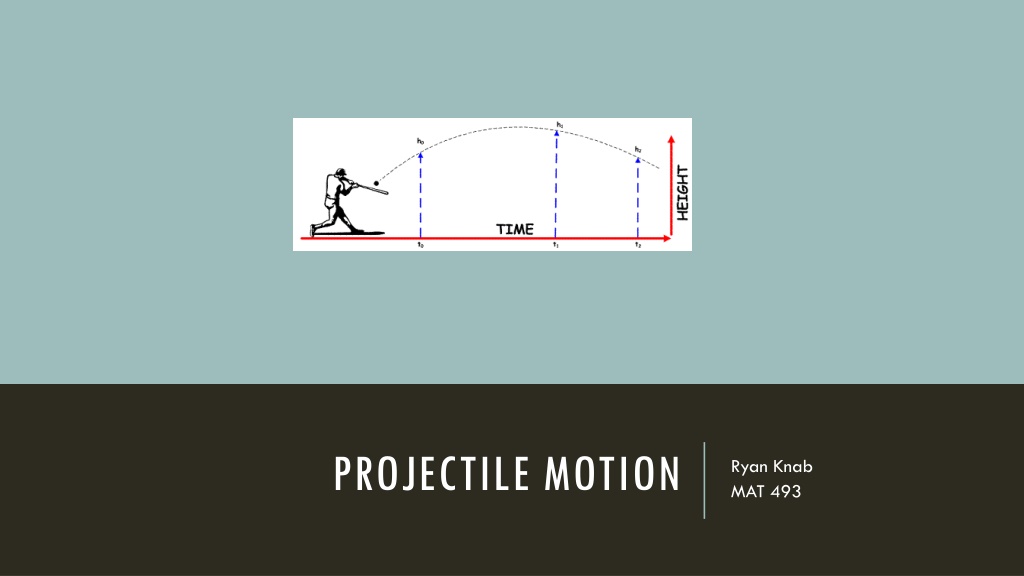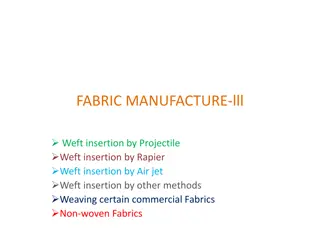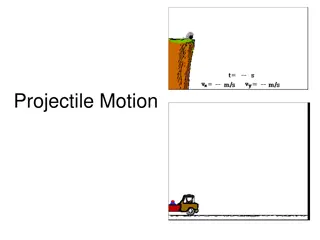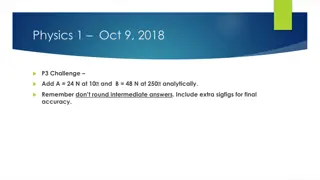Understanding Projectile Motion in Physics
Projectile motion is the motion of an object near the Earth's surface influenced by gravity. This concept has a historical background from Aristotle to Galileo and Newton, with forces like gravity and air resistance playing crucial roles. Models with and without air resistance are discussed, leading to differential equations and solutions for analyzing projectile motion scenarios.
Download Presentation

Please find below an Image/Link to download the presentation.
The content on the website is provided AS IS for your information and personal use only. It may not be sold, licensed, or shared on other websites without obtaining consent from the author. Download presentation by click this link. If you encounter any issues during the download, it is possible that the publisher has removed the file from their server.
E N D
Presentation Transcript
PROJECTILE MOTION Ryan Knab MAT 493
DEFINITION Projectile Motion is defined as the motion of an object near the earth s surface. Near Gravity extremely influential to the trajectory of an object
HISTORY Aristotle projectiles pushed along by some external force that was transmitted through the air called impetus Moved in a straight line until object lost momentum, then fell straight to the ground Galileo performed experiments on uniformly accelerated motion Ball rolled with uniform motion until falling off the table Noted time was the same no matter how fast the marble was moving horizontally Vertical and horizontal directions do not depend on each other Newton Three laws of motion: 1686 Law 1: uniform motion until external force will change state Law 2: sum of forces in each direction must be equal to mass*acceleration in specific direction
m ?2?(?) ??2 = -rx m ?2?(?) ??2 = -ry m ?2?(?) ??2 = -rz ??(?) ?? + Fx(t) ??(?) ?? +) Fy(t) ??(?) ?? -mg + Fz(t) CREATING A MODEL Forces in x-direction = m ?2? ? ??2 Forces in y-direction = m ?2? ? Reduce to first order differential equation with change of variables: ??2 Forces in z-direction = m ?2?(?) ??2 ??, V x = ?2?(?) ??, V y = ?2?(?) ??, V z = ?2?(?) Vx =??(?) Vy = ??(?) Vz = ??(?) ??2 What are some possible forces? Gravity? Air resistance? Wind? ??2 Assume air resistance proportional to velocity ??2
PROJECTILE MOTION MODELS 1 AND 2 Model 1: No air resistance Model 2: Air resistance proportional to velocity m V x = Fx(t) m V y = Fy(t) m V z = Fz(t) ?? 0 = ??0 ?? 0 = ??0 ?? 0 = ??0 m V x = -rxVx + Fx(t) m V y = -ryVy + Fy(t) m V z = -rzVz + Fz(t) ?? 0 = ??0 ?? 0 = ??0 ?? 0 = ??0
H-CP Model 2 Model 1 ?? ? 0 0 0 ?? ?? ?? ?? ?? ?? ?? ?? ?? 0 0 0 0 0 0 0 0 0 ?? ?? ?? ?? ?? ?? ?? ? 0 = = 0 ?? 0 ? ??0 ??0 ??0 ??0 ??0 ??0 ?? ?? ?? ? = ? =
H-CP SOLUTIONS: U(T) = ????0 Model 1 ?? ?? ?? Model 2 ? ?? ? ?? ? ?? ??0 ??0 ??0 ????? ?? ?? ?? = ????? = ?????
H-CP GRAPH H-CP Solutions do not physically make sense, we are not taking account for gravity Can we find a better way to model the motion?
NON-CP Model 2 Model 1 ?? ? 0 0 0 ?? ?? ?? m = mass, g = gravity(9.8m/s) ?? ?? ?? 0 0 0 0 0 0 0 0 0 0 0 ?? ?? ?? ?? ?? ?? 0 0 ?? ? 0 = , + = , 0 + ?? ?? ?? 0 ? m = mass, g = gravity(9.8m/s) ?? ?? ?? ??0 ??0 ??0 ?? ?? ?? ??0 ??0 ??0 ? = ? =
NON-CP SOLUTIONS: U(T) = ????0+ 0 ???(? ?)? ? ?? Model 1 ?? ?? ?? Model 2 ? ?? ? ?? ????? ??0 ??0 ?? ?? ?? = ????? = ??0 ??? ? ?? ????? ?2?? ???2? ?? According to theorem 5.3.1, if the forcing function is continuous in each direction for the entire time interval, we can say the Non-CP IVP has a unique solution given by the variation of parameters formula
PROJECTILE MOTION MODEL 3 Even more realistic of a model would be air resistance proportional to velocity squared Model 3: Air resistance proportional to velocity squared m V x = - (c1 + c2 ??0)Vx + Fx(t) This causes some problems: Cant just square velocity always positive No longer linear m V y = - (c1 + c2 ??0)Vy + Fy(t) m V z = - (c1 + c2 ??0)Vz + Fz(t) ?? 0 = ??0 ,?? 0 = ??0 ,?? 0 = ??0 ?????? ?????? ?????? Use some constant that can relate: c1 + c2 ?0
NON-CP GRAPHS Non-CP Model 3 Non-CP Model 2 R=0.01 + .005 ?0 R=0.01
PROJECTILE MOTION MODEL 4 Model 4: Air resistance proportional to square of speed m V x = -?? ??2+ ??2+ ??2?? + Fx(t,??, ??, ??) m V y = -?? ??2+ ??2+ ??2?? + Fy(t,??, ??, ??) m V z = -?? ??2+ ??2+ ??2??+ Fz(t,??, ??, ??) ?? 0 = ??0 ,?? 0 = ??0 ,?? 0 = ??0
SEMI-CP: MODEL 4 ?? ??2+ ??2+ ??2?? ?? ?? ?? ?? ?? ?? 0 0 0 0 0 0 0 0 0 ?? ??2+ ??2+ ??2?? = + ?? ??2+ ??2+ ??2?? ?? m = mass, g = gravity (9.8m/s) ?? ?? ?? ??0 ??0 ??0 ? =
SEMI-CP SOLUTION Model 4 ?? ??2+ ??2+ ??2?? ?? ?? ?? ??0 ??0 ??0 ? ?? ??2+ ??2+ ??2?? + 0 = ?? ?? ??2+ ??2+ ??2?? ??
THE GREEN MONSTER Left field, Fenway Park 95.4 meters away from home plate 11 meters tall X-coordinate third base line Y-coordinate first base line ???????????= 45.15 cos(29) = 39.49 m/s ?????????= 45.15 sin(29) = 21.89 m/s ??= 39.49 sin(75) = 38.14 m/s Launch angle? 29 degrees ??= 39.49 cos(75) = 10.22 m/s Batted ball speed? 45.15 m/s ??= ????????? = 21.89 m/s Initial height? 0.82 meters Official baseball mass? 0.145kg
HOMERUNS? o = Linear Resistance; * = Quadratic Resistance 40 35 Using our realistic velocities to ensure the appropriate launch angle and direction along with a coefficient value of 0.005 will result in the ball flight we are looking for 30 25 20 15 If the resistance were to be any greater or the initial velocities any slower, may not have a homerun 10 5 In order to ensure homeruns, either raise initial velocities or lower the quadratic coefficient below 0.005 0 90 80 70 60 50 40 30 20 10 0 x























